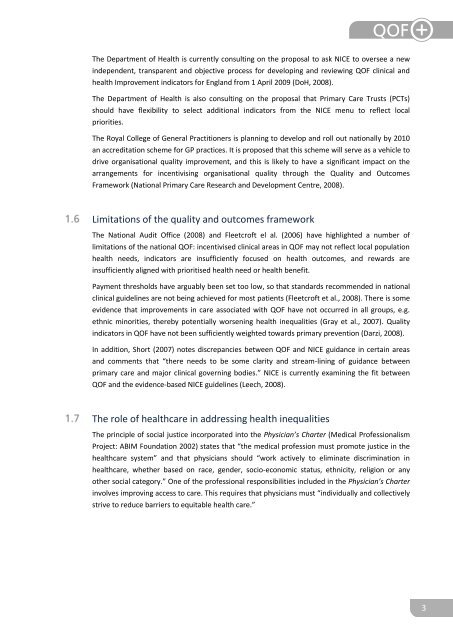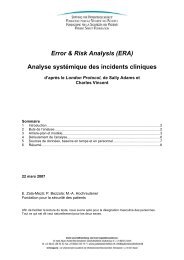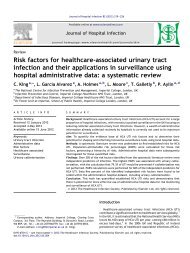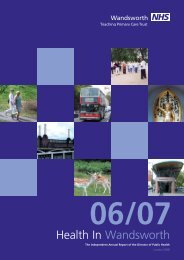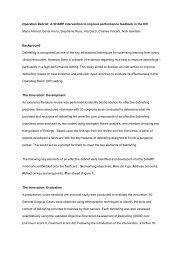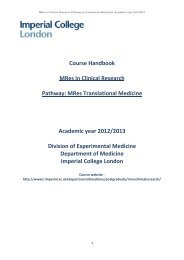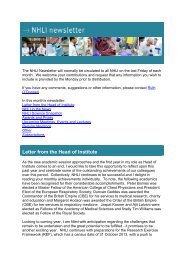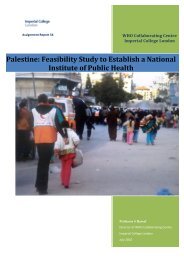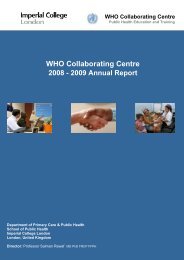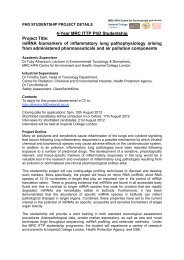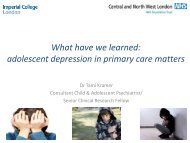QOF Plus Year 1 - Imperial College London
QOF Plus Year 1 - Imperial College London
QOF Plus Year 1 - Imperial College London
You also want an ePaper? Increase the reach of your titles
YUMPU automatically turns print PDFs into web optimized ePapers that Google loves.
The Department of Health is currently consulting on the proposal to ask NICE to oversee a newindependent, transparent and objective process for developing and reviewing <strong>QOF</strong> clinical andhealth Improvement indicators for England from 1 April 2009 (DoH, 2008).The Department of Health is also consulting on the proposal that Primary Care Trusts (PCTs)should have flexibility to select additional indicators from the NICE menu to reflect localpriorities.The Royal <strong>College</strong> of General Practitioners is planning to develop and roll out nationally by 2010an accreditation scheme for GP practices. It is proposed that this scheme will serve as a vehicle todrive organisational quality improvement, and this is likely to have a significant impact on thearrangements for incentivising organisational quality through the Quality and OutcomesFramework (National Primary Care Research and Development Centre, 2008).Limitations of the quality and outcomes frameworkThe National Audit Office (2008) and Fleetcroft el al. (2006) have highlighted a number oflimitations of the national <strong>QOF</strong>: incentivised clinical areas in <strong>QOF</strong> may not reflect local populationhealth needs, indicators are insufficiently focused on health outcomes, and rewards areinsufficiently aligned with prioritised health need or health benefit.Payment thresholds have arguably been set too low, so that standards recommended in nationalclinical guidelines are not being achieved for most patients (Fleetcroft et al., 2008). There is someevidence that improvements in care associated with <strong>QOF</strong> have not occurred in all groups, e.g.ethnic minorities, thereby potentially worsening health inequalities (Gray et al., 2007). Qualityindicators in <strong>QOF</strong> have not been sufficiently weighted towards primary prevention (Darzi, 2008).In addition, Short (2007) notes discrepancies between <strong>QOF</strong> and NICE guidance in certain areasand comments that “there needs to be some clarity and stream-lining of guidance betweenprimary care and major clinical governing bodies.” NICE is currently examining the fit between<strong>QOF</strong> and the evidence-based NICE guidelines (Leech, 2008).The role of healthcare in addressing health inequalitiesThe principle of social justice incorporated into the Physician’s Charter (Medical ProfessionalismProject: ABIM Foundation 2002) states that “the medical profession must promote justice in thehealthcare system” and that physicians should “work actively to eliminate discrimination inhealthcare, whether based on race, gender, socio-economic status, ethnicity, religion or anyother social category.” One of the professional responsibilities included in the Physician’s Charterinvolves improving access to care. This requires that physicians must “individually and collectivelystrive to reduce barriers to equitable health care.”3


